Products
949 Compact Wheel Loader
Luyu Machinery is an industry and trade integrated construction machinery manufacturer, focusing on the design, production and sales of various construction machinery equipment, the company in the construction machinery industry has a wealth of experience and excellent technical strength, committed to provide customers with high quality, high-performance solutions. We have a professional R & D team and engineer team, with a wealth of technical strength. Committed to continuous innovation and improvement of product design, the introduction of advanced manufacturing technology and process to provide excellent performance, durable and reliable loader equipment. The 949 Compact Wheel Loader is a full-featured wheel loader that can be used in a variety of environments such as earthworks, construction sites and mines.
Send Inquiry
Product Description
The hydraulic cylinder is a very important part of the 949 small wheel loader. In daily use, it may be damaged by some external debris, leaving scratches, which will destroy the sealing performance of the hydraulic cylinder and lead to hydraulic oil leakage. This will reduce the working pressure and efficiency of the hydraulic system, resulting in reduced performance of the 949 small wheel loader, in addition, the leaking hydraulic oil may contaminate the working environment, creating a danger to other machine components and operators. The seals of the hydraulic cylinder will also be damaged as a result, such as seals and O-rings. Seal failure will cause the hydraulic cylinder internal and external pressure imbalance, reduce the operation accuracy and stability of the 949 Compact Wheel Loader. At the same time, seal failure can also lead to the entry of dust, moisture or other impurities, accelerating the wear and failure of the hydraulic cylinder. Scratches will also increase the friction and resistance inside the hydraulic cylinder, making the efficiency of the hydraulic system decrease. The smooth movement and responsiveness of the hydraulic cylinder are affected, which affects the operational performance and response time of the loader. If the scratch is very serious or neglected to repair, it may lead to further damage to the cylinder, and the scratch may expand or deepen, damaging the internal structure and parts of the hydraulic cylinder. This will cause the hydraulic cylinder to fail, requiring the entire cylinder to be replaced, increasing maintenance costs and downtime.
|
Bucket capacity |
1.2 m³ |
|
Bucket width |
2000 mm |
|
Ratedload |
2800 kg |
|
Total weight |
6400 kg |
|
Engine type |
YN4108T 90KW/122HP |
|
Overall size |
6725*2230*3020 mm |
|
Dumping height |
3800 mm |
|
Minimum ground clearance |
380 mm |
|
Minimumturning radius |
3500 mm |
|
Tyre |
16/70-24 |
When we find that the hydraulic cylinder of the 949 small wheel loader has scratches, we can use these treatment methods. First check the depth and length of the scratch. If the scratch is shallow and does not affect the normal operation and sealing performance of the cylinder, you can consider continuing to use the cylinder without repair. However, if the scratch is deep or long, it may negatively affect the performance and life of the 949 small wheel loader cylinder, requiring further action. For shallower scratches, try using grinding tools and grinding fluids for light grinding and polishing. This can help reduce the depth and roughness of scratches and restore the smoothness of the cylinder surface. Before grinding and polishing, be sure to take proper safety measures and follow the manufacturer's recommendations and guidance. For deeper or longer scratches, a more complex repair process may be required. This includes surface coating or chrome restoration. Surface coating involves applying a special coating or paint to a scratched area to fill in and smooth the scratch. Chrome repair is to deposit a chromium layer on the scratch surface to restore smoothness and wear resistance. These repair methods usually require professional equipment and technology, so it is best to entrust the 949 small wheel loader to an experienced professional maintenance organization for processing, if the scratch is too deep or the repair is ineffective, it may be necessary to consider replacing the hydraulic cylinder. The hydraulic cylinder is a critical hydraulic component that is critical to the proper operation and safety of the 949 small wheel loader. If scratches have a serious impact on cylinder performance and sealing performance, replacing the cylinder is the most reliable solution.
In order to avoid scratches on the hydraulic cylinder of the 949 small wheel loader, we should regularly check and maintain the surface smoothness of the hydraulic cylinder, and ensure that the surface is thoroughly cleaned before checking the hydraulic cylinder. Clean the surface of the hydraulic cylinder with a cleaner or solvent to remove dust, dirt and oil. You can wipe with a brush and a soft cloth to ensure that the surface is clean. Check the outer surface of the hydraulic cylinder carefully. Look for any visible scratches, scuffs, dents, or other signs of damage. Use your hand to touch the surface and check for any noticeable bumps or unevenness. Pay special attention to sealing areas and surfaces around the piston rod, as they are common areas for leaks and seal failures. If necessary, you can use some professional measuring tools, such as scraper, scratch meter or haptometer, to evaluate the smoothness and flatness of the hydraulic cylinder surface. These tools can help determine the depth and length of the scratch, as well as the flatness of the surface. According to the manufacturer's specifications and recommendations, determine whether the surface meets the requirements. If the hydraulic cylinder surface is found to be scratched or damaged, take appropriate maintenance and repair measures according to the situation. In the maintenance process, record the inspection results, maintenance records and maintenance plans of the 949 small wheel loader hydraulic cylinder. This helps track the cylinder's condition and maintenance history, as well as specify a schedule for the next maintenance and inspection.



















